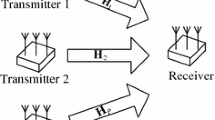Abstract
In a multicarrier direct-sequence code-division multiple access (MC DS CDMA) system, different fading channels for different users and/or different carriers are correlated in general; thus a vector channel model is more appropriate than disjoint scalar channel models. For multiuser MC DS CDMA systems, we propose (1) a generalized vector autoregressive model which accounts for correlation between different user/carrier fading channels, (2) the use of a two-phased algorithm to obtain the proposed model’s parameters, and (3) a receiver structure that consists of a generalized decorrelator followed by maximal-ratio combining (MRC) of uncorrelated carrier channel outputs of each user. The estimated fading coefficients provide the necessary quantities to MRC. The computer simulation results show that the proposed scheme has performance close to the case in which the channel is perfectly known, and outperforms separate scalar channel estimation case.
Similar content being viewed by others
References
Verdu S. (1998) Multiuser Detection. Cambridge, Cambridge University Press
P. Wu and A. Duel-Hallen, “Multiuser detectors with disjoint Kalman channel estimators for synchronous CDMA mobile radio channels”, IEEE Trans. Commun., Vol. 48, No. 5, pp. 752–756, May 2000.
S. Kondo and L.B. Milstein, “Performance of multicarrier DS CDMA systems”, IEEE Trans. Commun., Vol. 44, No. 2, pp. 238–246, Feb. 1996.
Simon M.K., Alouini M.-S. (2000) Digital Communication over Fading Channels: a unified approach to performance analysis. New York, Wiley
T.K. Moon, “The expectation-maximization algorithm”, IEEE Signal Process Mag., Vol. 13, No. 6, pp. 47–60, Nov. 1996.
K.Y. Lee and S. Jung, “Time-domain approach using multiple Kalman filters and EM algorithm to speech enhancement with non-stationary noise”, IEEE Trans. Speech Audio Process., Vol. 8, No. 3, pp. 282–291, May 2000.
W. Turin, “MAP decoding in channels with memory”, IEEE Trans. Commun., Vol. 48, No. 5, pp. 757–763, May 2000.
W. Gao, S. Tsai, and J.S. Lehnert, “Diversity combining of a fast-varying, correlated multipath fading channel for direct-sequence spread-spectrum systems”, Proc. IEEE Veh. Technol. Conf. (VTC’00), Vol. 3, pp. 1445–1451, 24–28 Sept. 2000.
W. Gao, S. Tsai, and J.S. Lehnert, “Blind adaptive estimation and diversity combining of a fast varying, correlated multipath channel for DS/SS systems,” Proc. IEEE Mil. Commun. Conf. (MILCOM’ 00), Vol. 2, pp. 759–763 22–25, October, 2000.
S.-M. Tseng and H.-C. Yu, “Vector Channel Estimation and Multiuser Detection for Multicarrier DS CDMA in Time and Frequency Selective Fading Channels”, IEEE Wireless Commun. Networking Conf. (WCNC 2004), Atlanta, GA, USA, vol. 1, pp. 18–23, Mar. 2004.
X. Wang and R.J. Ray Liu, “Adaptive channel estimation using cyclic prefix in multicarrier modulation system”, IEEE Commun. Lett., Vol. 3, No. 10, pp. 291–293, Oct. 1999.
A.M. Kuzminskiy, “Finite amount of data effects in spatio-temporal filtering for equalization and interference rejection in short burst wireless communications”, Signal Process, Vol. 80, pp. 1987–1997, 2000.
J.M. Mendel, Lessons in Estimation Theory for Signal Processing, Communications, and Control, Englewood Cliffs, New Jersey, Prentice-Hall, 2nd Edition, 1995.
S.-M. Tseng and Y. Zheng, “Fuzzy two-stage carrier synchronization”, Fuzzy Sets and Systems, Vol. 102, No. 2, pp. 211–219, Mar. 1999.
S.-M. Tseng and Y. Zheng, “Adaptive fuzzy frequency estimator with applications in fading communication channels”, Fuzzy Sets Syst., Vol. 114, No. 2, pp. 255–259, Sep. 2000.
P. Dent, G.E. Bottomley, and T. Croft, “Jakes fading model revisited”, Electro. Lett., Vol. 29, No. 13, pp. 1162–1163, June 1993.
Author information
Authors and Affiliations
Corresponding author
Rights and permissions
About this article
Cite this article
Tseng, Sm. Vector Channel Estimation and Multiuser Detection for Multicarrier DS CDMA in Time and Frequency Selective Fading Channels. Wireless Pers Commun 43, 481–494 (2007). https://doi.org/10.1007/s11277-006-9245-0
Received:
Accepted:
Published:
Issue Date:
DOI: https://doi.org/10.1007/s11277-006-9245-0




